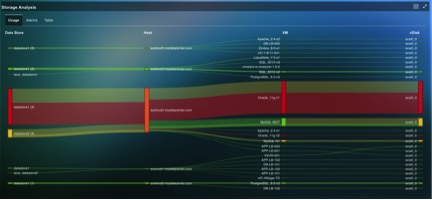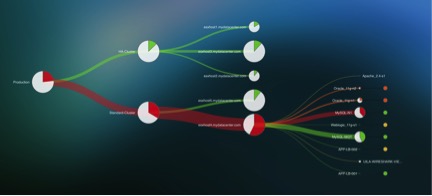Bridging the Gap between Virtual and Physical Infrastructure Management Silos
A network engineer should be able to view the entire stack from the physical layer to the applications running on VMs. This should include the following as illustrated in Figure 1: Top of Rack
switch, physical hosts connected to the Top of Rack switch, Distributed vSwitches and port groups (VLAN, VxLAN, etc), virtual machines deployed on the physical hosts and the kinds of application
traffic passing through all these layers. This at-a-glance view of the full stack enables the Network Engineer to quickly identify the VM and application services that have issues (color coded in
red) and correlate them to the physical host and the switch that are associated with this VM (application servers).
• Physical and centralized storage devices (fiber channel, iSCSI, etc.);
• Physical host storage;
• Virtual storage (logical datastore);
• Virtual Machine storage (vDisk); and
• Virtualized Application services.
Such a view might look like the one in Figure 2.


Figure 2: A storage engineer’s full stack view
A storage engineer should be able to view the entire stack all the way from the data store to the performance relating to storage of applications running on VMs. This should include the following as illustrated in Figure 2: Logical data store (which groups together a number of physical hosts), physical hosts associated with these data stores, virtual machines deployed on the physical hosts and the virtual disk accessed by these VMs. This at-a-glance view of the full stack enables the storage engineer to quickly identify the vDisk and VM that have issues (color coded in red) and correlate it to the logical data stores and physical hosts.
• Physical host clustering;
• Physical host;
• Virtual Machine; and
• Virtualization application services.
Such a view might look like the one in Figure 3.


Figure 3: A server administrator’s view.
The Storage Engineer’s View
For the storage engineer, full stack visibility should include:• Physical and centralized storage devices (fiber channel, iSCSI, etc.);
• Physical host storage;
• Virtual storage (logical datastore);
• Virtual Machine storage (vDisk); and
• Virtualized Application services.
Such a view might look like the one in Figure 2.


Figure 2: A storage engineer’s full stack view
A storage engineer should be able to view the entire stack all the way from the data store to the performance relating to storage of applications running on VMs. This should include the following as illustrated in Figure 2: Logical data store (which groups together a number of physical hosts), physical hosts associated with these data stores, virtual machines deployed on the physical hosts and the virtual disk accessed by these VMs. This at-a-glance view of the full stack enables the storage engineer to quickly identify the vDisk and VM that have issues (color coded in red) and correlate it to the logical data stores and physical hosts.
A Server Administrator’s View
For the server administrator, the full stack view should include:• Physical host clustering;
• Physical host;
• Virtual Machine; and
• Virtualization application services.
Such a view might look like the one in Figure 3.


Figure 3: A server administrator’s view.



















